
|

|

|

Caye Caulker has always had a few families for about 10,000 years.
The island sits in the middle of a natural feeding grounds and migratory
routes for many fish, the conch and lobster industries. These grounds
run about 8 miles in any seaward direction.
Recent population levels started with the Indian War of the Castes in
the Yucatan. When many mestizos of mixed Mayan and Spanish blood fled
the massacres occuring all over the Yucatan. This was the Mayan uprising
for defense of independence around 1868. The last visit of any
consequence for a few days, was the beaten armada of Spanish boats, that
got beat in the Battle of St. Georges Caye during the colonial era.
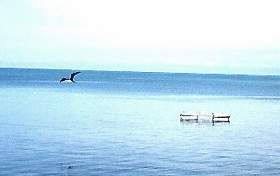
The current site of the village inhabitants has been unchanged as a
site for living by humans for thousands of years. The reasons are
geographic in nature. The bay at the back of the village provide shelter
for vessels, be they sailboats, or dugout canoes. In front of the
village, there is a fairly shallow lagoon area, between 6 inches and 14
feet deep running a mile to the eastward protecting Great Coral Barrier
Reef. In front of the village, the reef is known as a dry reef. The
reef comes to the surface, while further north, the reef is a deep reef
and waves pass over it around 8 feet deep. The shallow reef gives a
protected anchorage in front of this particular spot of the island. Not
only that, the holding ground is good with coral sand bottom. Whereas in
other parts, the bottom is a soft mushy mud and extremely difficult to
stay anchored there in a wild strong northerly weather front. These are
the natural geographic reasons for habitations at this particular spot
on the island.
When the War of the Castes was on, a man named Reyes got a Colonial
Grant for the whole island. He subsequently started selling off pieces
of it. His descendents today still live in the village of Caye Caulker.
They are the Reyes of the Paradise Hotel complex.
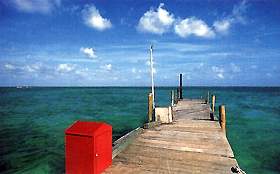
There have been about 3 major hurricanes sweep Caye Caulker clean of
human habitation since the first Reyes fled the War of the Castes in the
Yucatan. Another one is due any season. For the island is only 8 feet
high at the highest and a direct hit by the eye of a hurricane will push
a storm surge of artificially raised sea levels about 15 feet higher than
normal in front of it. The island is basically a sand bar over a
limestone shelf and inside the shelf of limestone are many huge
underwater caves. Several scuba divers have lost their lives exploring them.
During World War II, fishermen living on the island collected debris
from torpedoed ships in the Caribbean, that came floating ashore. The
most lucrative were bales of rubber. Today, bales of marijuana are more
common. The fishing industry supported about 80 families since World War
II and the island has a self regulating economy that controls how many
people can actual live there and support themselves. Currently the
diversified economy supports about 800 people all total. In good seasons
population rises and in bad seasons the population declines as people
move away.
When the British first started mapping, some cartographer in England
decided the spelling of the name was Corker. But there were some very
famous sailboat designers and shipwrights that developed on the island.
The Young family and the Alamina family were the most prominent. Since
then in recent years, many people build boats, either of wood, ferro
cement, or fiberglass. Boats were brought to the island for careening
and caulking. About 1960 the real spelling started to come back into
vogue locally and as communications and the information age has expanded,
the current spelling is more common. Though in England where they make
the maps, the cartographers still spell it the way they want it.
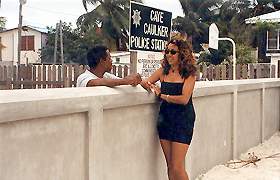
During Hurricane Hattie in 1961, the storm swept across the narrow part
of the village. It lifted the wooden schoolhouse off it's tall posts and
dropped it between waves, cracking it open like an egg shell. Most
children had been in the schoolhouse as a shelter. !3 people died in
all, mostly children. The Hurricane Eye and storm surge hit the mainland
port 21 miles to the south and buried that port city under 16 feet of
water. The village of Calabash Caye on Turneffe Atoll, disappeared
totally with it's nearly 300 residents. Because Hurricane Hattie went
south of Caye Caulker, only the edge of the storm hit the island, but
that was bad enough. Out of 90 houses only 8 survived completely. The
village council managed to get tools from the mainland, Governor
Thornley's Emergency Committee, and formed teams to do various type
work. About 42 houses were built in a few weeks. Ray Auxillou was the
Governor's representative at the time and by the time the mainland people
had got themselves organized a month later and saw their first visit from
elected representative Louise Sylvestre, the most of the rehabilition
work had been done to their their surprise. The British Army helped a
lot, a week after the hurricane with helicopters and medical and food
supplies. Caye Caulker remains a vulnerable place for a directly hitting
hurricane, because of high winds and storm surge, being a low lying island.
Tourism first started in 1964, with a few visitors on weekends from the
mainland Belleview Hotel, brought out by a local boat called 'Sailfish',
built by a schoolteacher beside the then Teachers House. The early
tourists were mostly agency people dealing with the Belize Government.
Around 1969, Dr. Hildebrand of the University of Corpus Christi started
visiting each winter with a Marine Biology Expedition of around 24
students and they camped in the village. Backpackers found their way to
the island, but transportation then was still haphazard by fishing
sailboats. The service was irregular. There was no accomodation. The
Auxillou family pioneered the tourism industry and the first Scuba Diving
lessons and trips were started around the late 1960's.
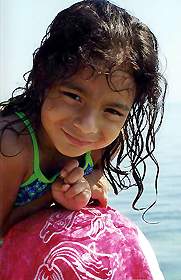
As speedboats came in using outboard motors, the fishing cooperative
put in an electrical plant, the tourist visitors became more regular.
During the 1970's, the hippie crowd following the GRINGO TRAIL, which was
Isla Mujeres, Tulum, Caye Caulker, Tikal and Lake Atitlan in Guatemala.
The reputation spread by word of mouth. Many marijuana smugglers of the
gentler time of family smuggling to the USA, in the 1970's came as
tourists to the island village to wait for their loads to get ready.
Sometimes this took months.
The economy then was still mostly fishing and lobster traps. Coconut
oil was produced mostly by widows as a cash product for sale in the
mainland port market. It was always small scale.
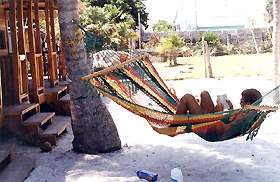
Up to the 1960's the lobster industry was serviced by ex-world War II
amphibian aircraft out of Florida, that landed in the bay behind the
village. Eventually, the lobster industry got developed more
consistantly by several Americans who built freezer plants on the
mainland. But prices were only around 4 cents a pound. Tony Vega, still
alive in the village, wanted better prices for himself and managed to
convince others to join him. The approach decided on was a Cooperative.
The mainland government of the PUP fought the idea hard. They said
fishermen could not cooperate and besides the port town on the mainland
was going through the throes of a growing political movement and the port
townies were looking to control the whole country under a plantation
model of self government. The townie politicians then were getting
favors and money from the lobster buyers with freezer plants and did not
want locals to invest and develop resources themselves. The situation
has not change since that day and the same political bought townies
scenario still exists.
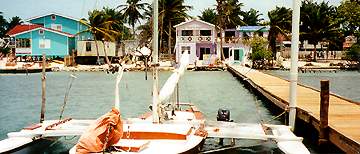
Tony Vega led the fight and this writer was a founding member of this
cooperative movement. The US Peace Corps played a role in it's success.
The townies were not that far wrong in their opinion of fishermen. The
cooperative meetings in the village were loud, wild and raucous. Fights
could be found afterward. There were a number of cliques that formed to
exploit the situation for personal gain, like in any new political
movement. Several Peace Corps volunteers were arranged throughout the
years and the only direction was to keep the cooperative going. Village
feuds were common. But the sane voice of reason and impartial Peace
Corps volunteers smoothed the way and after about 13 years of rough and
ready development problems, the Northern Fisherman's Cooperative became
such a success, the United Nations organizations brought people from all
over the world to study it. It is still an example for the rest of the
world. Though locally in the village in recent years, tourism has
replaced lobster as an easier way to earn money. The Cooperative members
from the village found this fact out, when they lost control of their
cooperative to a rural farming/lobster village called Sartenja up the
coast line in Corozal Bay.
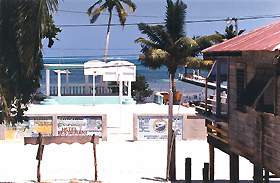
Nowadays, the diversified economy of the village still includes
lobster, fish and tourists. Internet e-commerce is growing in a small
way, mostly held back by a telecommunictions monopoly on the mainland.
The Belize Development Trust introduced by volunteer, Peter Singfield, a
Canadian Web page robot, that would let villagers access the internet
through e-mail and e-commerce is slowly expanding in small way in the
village. Web pages are common for villagers nowadays, cable t.v., and
all the accoutraments of modern society. Real development is still
waiting for the telecommunications monopoly to expire, so a village
Internet Service Provider and server can go in business. But these
problems are the usual mainland political holdups. They are not
technical or financial.
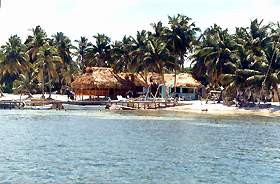
Nobody wants to work hard in Caye Caulker. They have done enough of
that. Mostly they want a two or three hours a day work, or 5 hours for
three days a week, or some such set up. They are accustomed to working
hard in a lobster season for three months and then having lots of slow
leisure time to do whatever is needed the rest of the year. Life is
simple if you want it, or costly if you can afford it. Your gadgets that
own you, dictate how hard you want to work on the island. With fish in
the sea, it is easy to eat and the weather is nice, so socializing is the
prefered way of life. Not a struggle for money.
History courtesy of Ray Auxillou. Thanks a bunch Ray!
 Caye Caulker.org Home |
Search |
Island Information |
Quick Facts (HELP!) |
Goods & Services |
Diving
Caye Caulker.org Home |
Search |
Island Information |
Quick Facts (HELP!) |
Goods & Services |
Diving
Fishing |
Lodging |
Tours |
Photos |
Message Board |
History |
Activities
© Copyright Island Girls
|

 Caye Caulker.org Home |
Search |
Island Information |
Quick Facts (HELP!) |
Goods & Services |
Diving
Caye Caulker.org Home |
Search |
Island Information |
Quick Facts (HELP!) |
Goods & Services |
Diving









